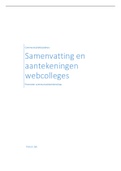Summary
Summary Communication classifiers (S_CK)
- Course
- Institution
COMPLETE SUMMARY - With summary of all articles (22) of all modules (9) + notes of all webcolleges (9)! Some articles were scanned, so the most important pieces were added as an image.
[Show more]



